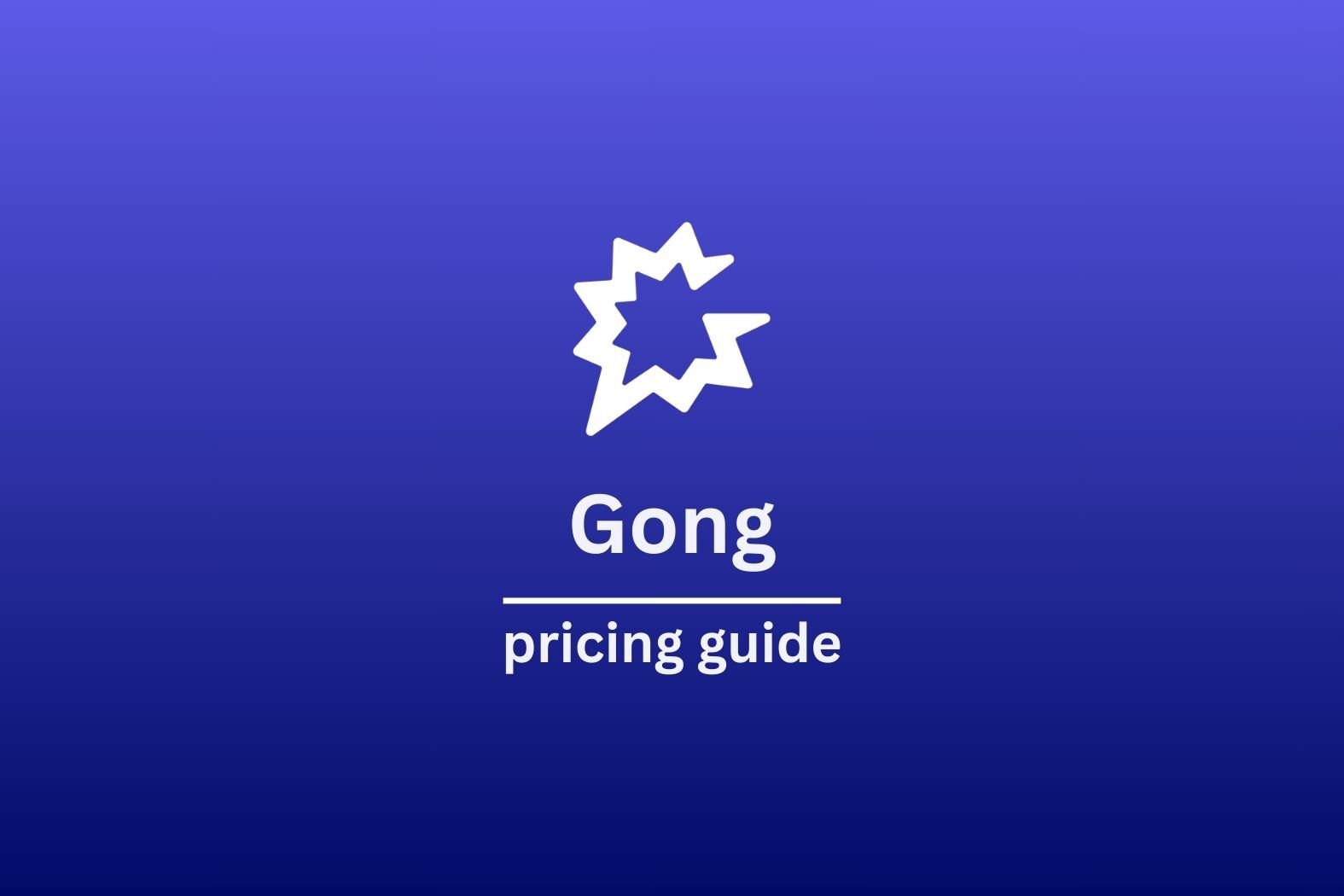tl;dv vs Gong – which of these two AI-driven sales tools is the right choice for your sales team, or your business in general?
If you are involved in any type of sales then it’s highly likely that you will have heard of Gong. If not, then Gong is a well-known AI-driven revenue intelligence platform that provides deep insights into sales conversations.
This tool also analyzes prospect and customer interactions, helping all manners of sales teams to understand what is working in their sales process, and what doesn’t. It then offers actionable insights with the goal of helping close more deals, more effectively.
With features like call recording, transcription, and AI-powered analytics, Gong helps sales reps improve their techniques, identify high-potential leads, and enhance overall sales performance. Understandably with a tool that’s geared up to generate more sales and conversions, it comes with a very large price tag.
On the other hand, tl;dv focuses on enhancing remote work productivity by offering AI-driven meeting recording and transcription services. While it’s not as specialized in sales as Gong it does have sales functionality above other options, meaning it can be incredibly useful for teams that rely heavily on meetings to drive their business as well as sales insight.
tl;dv allows you to record, transcribe, and share meetings effortlessly, making it easier to revisit key points and ensure everyone is aligned. Its strength lies in its simplicity and ease of use, providing value by saving time and ensuring clarity in communication.
If you are looking for a factual comparison guide to help you to decide which sales tool to go for – whether or not it’s with investing in the more hefty, sales-focused Gong, or if something a bit less may suit your needs then this guide will help you to explore each of the tools features, characteristics and benefits, and also where these may lack as well.
We’ll also go into how they can integrate with your current tech stack, and whether or not they benefit your customer as well as your sales team in areas such as security and compliance.
At the end of this you should have a clearer understanding of what is going to work best for your needs.
tl;dr
| tl;dv | Gong | |
|---|---|---|
| Transcription | 19 | 24 🟢 |
| Recording | 15 | 18 🟢 |
| Conversational Intelligence | 14 | 16 🟢 |
| Automation & Integrations | 10 | 10 |
| Note-taking | 10 | 12 🟢 |
| Security | 20 🟢 | 8 |
| Coaching | 8 | 8 |
| Admin | 8 🟢 | 4 |
| Organizational | 12 | 12 |
| Support | 4 🟢 | 2 |
| Revenue Intelligence | 0 | 8 🟢 |
| Other | 8 🟢 | 4 |
| Total | 128 🟢 | 122 |

Sales enablement is an all-encompassing term for making sure your sales team is operating at full potential. Put it into action now!
tl;dv vs Gong: 12 Factors to consider while choosing the best AI Notetaker
How do we rank?
- We give 2 points to a platform once it is the clear winner or when the capability is equally met by the other.
- We give 1 point when the capability is present, but it’s not a winner.
- We give 0 points when the capability is not present.
Transcription capabilities
| tl;dv (19) | Gong (24) | |
|---|---|---|
| Transcriptions included | 🟢 Unlimited | 🟢 Unlimited |
| Real-time transcriptions | 🔴 | 🟢 |
| Languages supported | 🟠 +30 | 🟢 |
| Dialects supported | 🟢 | 🟢 |
| Filler word removal | 🔴 soon | 🟢 |
| Speaker recognition | 🟢 | 🟢 |
| Speaker names | 🟢 | 🟢 |
| Transcribe video/audio uploads | 🟢 Capped at 3 recordings per month on free | 🟢 |
| Export transcripts | 🟢 | 🟢 |
| Clips from transcript | 🟢 | 🟢 |
| Custom vocabulary | 🔴 soon | 🔴 |
| Full-Transcript search | 🟢 | 🟢 |
| Edit transcription | 🟢 | 🟢 |
Languages Supported
Sales is very much global nowadays, and selling across the world is much more commonplace than it was pre-Internet and remote work. As a result both tools boast an impressive amount of languages supported. tl;dv supports in excess of 30+ languages, whereas Gong offers coverage for 70+. And while it seems that Gong has the higher amount, there are a couple of things to note here.
Gong has what they call “Hyper Optimized” languages, meaning that these are the core languages it supports. There are 9 of these and some of the features that Gong offers are not supported in these languages. French Canadian for example, while widely spoken across most of Canada, is not covered at present – this could be an issue with there being some large differences in the two languages.
Then there are the “Standard” languages which are more wide ranging, however these include various dialects such as Galician, Catalan & Basque. Many of these would come under dialects on tl;dv, but are also not supported by many of Gong’s other features.
While the 70+ number is impressive, just take note that if you are working outside of English, Parisian French or standardized German for example, you may not be able to access all of the features of the tool.
Filler Word Removal
Gong’s approach to filler word removal is more focused on enhancing the quality of sales call analyses by identifying and highlighting excessive use of common filler words. Their technology assesses the frequency of filler words within a call relative to their typical prevalence in the language.
Detection Method: Gong measures both the absolute and relative frequency of filler words during a call.
Criteria for Highlighting: Filler words are highlighted only if their usage significantly exceeds normal conversational standards, based on a predefined threshold.
Vocalized Pauses: Words such as “um,” “uhh,” and “hm” are categorized separately as vocalized pauses and are omitted from the transcript to improve readability, without being highlighted in the Points of Interest.
List of Detected Words: Includes a broad spectrum of common fillers such as “actually,” “like,” “you know,” among others.
tl;dv on the other hand is currently integrating a new feature into their transcription services aimed at producing cleaner, more concise transcripts by automatically removing filler words. This feature is designed to enhance the readability and utility of transcriptions by reducing unnecessary verbal clutter.
Custom Vocabulary
tl;dv is planning to enhance its transcription services by introducing the ability to incorporate custom vocabulary into transcriptions. This upcoming feature will allow users to tailor the service to better recognize and accurately transcribe technical or industry-specific language, significantly boosting transcription accuracy for specialized content.
In contrast, Gong already integrates custom vocabulary capabilities into its transcription services, which is particularly beneficial for sales and customer interaction environments where industry-specific terms are frequent. This feature enables Gong to provide highly accurate transcriptions tailored to the unique communication styles and terminology of its users. This is likely to be highly beneficial in super specialist sales environments such as technology, high-value machinery or other very big ticket items that are in specialized environments.
Recording capabilities
| tl;dv (15) | Gong (18) | |
|---|---|---|
| Video platforms | 🟠 Zoom, MS Teams, Google Meet | 🟢 Zoom, MS Teams, Google Meet + more |
| Storage | 🟢 Unlimited | 🟢 Unlimited |
| Records video | 🟢 | 🟢 |
| Concurrent meetings | 🟢 Unlimited | 🔴 |
| Download recordings | 🟢 | 🟢 |
| Capture slides | 🟢 | 🟢 |
| Viewing analytics | 🟢 | 🟢 |
| Integrated Calendar | 🔴 | 🟢 |
| Recording Editing | 🔴 | 🟢 |
| Reels | 🟢 | 🟢 called “Magic Clips” |
Video Platforms
Both tl;dv and Gong support multiple video conferencing platforms, reflecting that both have greater flexibility in terms of the type of conference software people can use to communicate with each other and reap the benefits of the features for each.
However, while both support Zoom, Google Meet and MS Teams, tl;dv doesn’t support Webex, BlueJeans, GoToMeeting and others.
This means that where tl;dv does not support Cisco’s Webex, this could potentially impact users within enterprises that rely on this service for communications. While these limitations might not pose significant issues for all companies, they could influence the choice of transcription service for organizations deeply integrated with one platform or the other.
Concurrent Meetings
tl;dv, unlike Gong by offers, the ability to handle concurrent meetings across all supported video conferencing platforms. This feature is highly beneficial for large organizations or teams with dense meeting schedules, ensuring that no key discussions are overlooked, even when they overlap. On the other hand, Gong does not currently support the transcription of concurrent meetings.
While Gong excels in providing detailed analyses and actionable insights from individual calls and meetings, particularly in sales environments, it may not meet the needs of users who require the capability to manage multiple meetings at the same time. This distinction is crucial for organizations that prioritize comprehensive coverage and efficiency in documenting and analyzing their communications across multiple platforms simultaneously.
Viewing Analytics
tl;dv offers viewing analytics that provide valuable insights into user engagement with recorded meetings. This feature allows you to see who has watched the recordings and when, which is particularly useful in sales contexts. For example, if a prospect repeatedly views a meeting recording or shares it with others, it signals a strong interest and potentially warrants a follow-up. This kind of analytic capability can guide sales teams on when and how to engage further based on viewer interest.
On the other hand, Gong also provides analytic tools, though it’s not specified whether they include the same type of viewing analytics as tl;dv. Gong’s focus is generally on enhancing sales strategies through conversation intelligence and detailed interaction analysis, which includes tracking participant engagement during the calls themselves. While Gong excels in offering insights derived from during-meeting interactions, it’s not clear if they track post-meeting engagement through recording views in the same way tl;dv does.
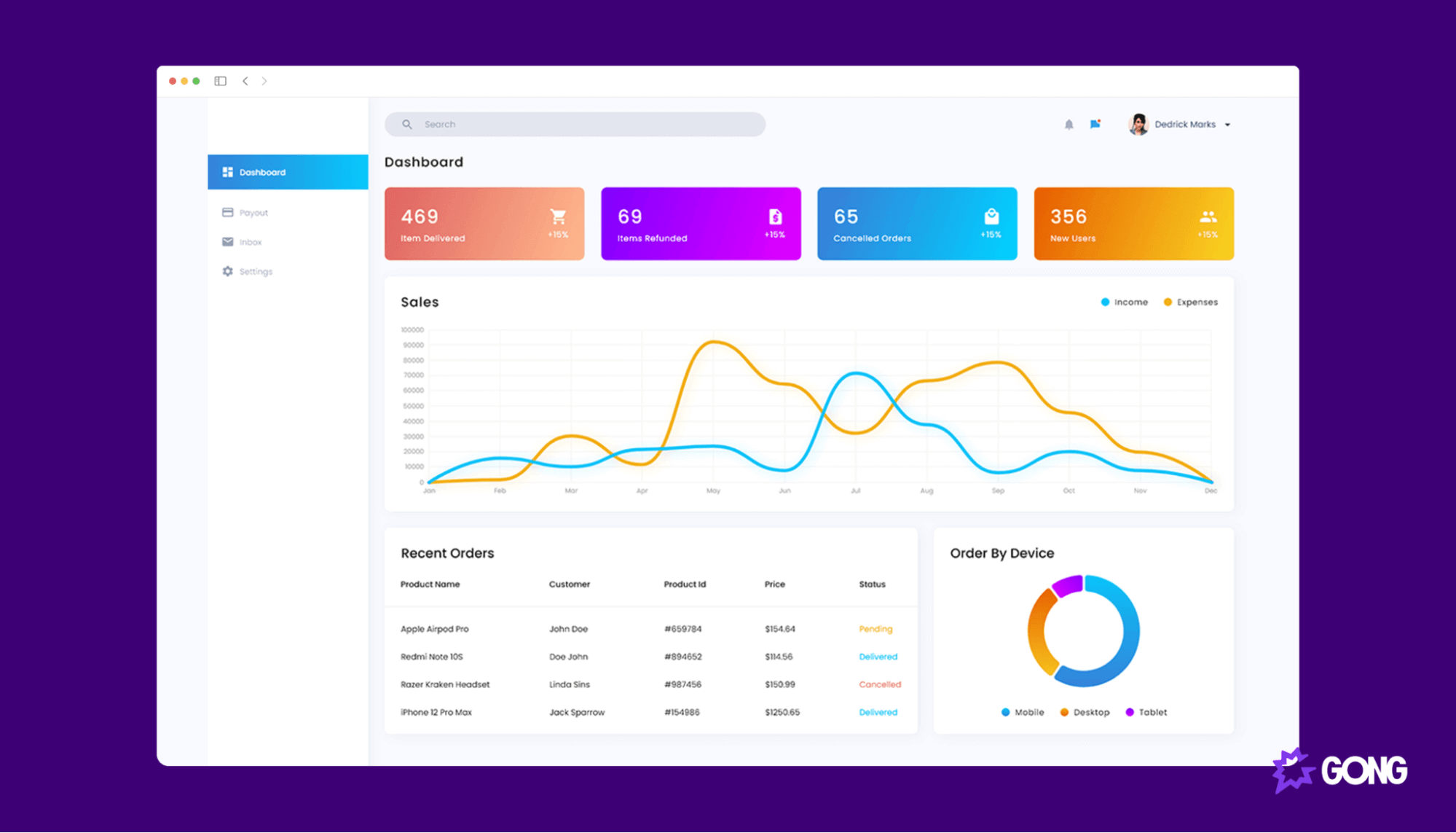
Conversation Intelligence capabilities
| tl;dv (14) | Gong (16) | |
|---|---|---|
| Single Meeting AI Insights | 🟢 | 🟢 |
| Multi Meeting AI Insights | 🟢 | 🟢 |
| Keyword tracking | 🟢 | 🟢 |
| Sentiment Analysis | 🔴 No, as per EU AI Act | 🟢 |
| Key Topic detection | 🟢 | 🟢 |
| Speech Analytics | 🟢 | 🟢 |
| Action item detection | 🟢 | 🟢 |
| Question detection | 🟢 | 🟢 |
Single Meeting AI Insights
Both tl;dv and Gong provide AI-driven insights for each meeting, but they focus on different aspects. tl;dv is centered on the content of the meetings, offering summaries and the ability to delve into specific questions, which helps users quickly grasp the essential points discussed. Gong, on the other hand, emphasizes the context and dynamics of conversations. It analyzes conversation flow, participant engagement, and sentiment to provide a nuanced understanding of the interaction. This helps identify communication patterns and areas for improvement.
Multi Meeting AI Insights
tl;dv stands out by offering insights across multiple meetings, enabling organizations to identify trends and gather insights over time. This feature is beneficial for compiling topics, action items, and key takeaways across several sessions, which is especially valuable for management oversight. Gong’s analytics are focused more on optimizing individual meetings and sales calls through detailed analysis, rather than providing aggregated insights across multiple meetings.
Sentiment Analysis
Gong incorporates sentiment analysis directly into its analytics, using AI to assess the tone and emotional engagement of participants during meetings. This feature is aimed at helping businesses understand the emotional underpinnings of discussions, which is essential for refining communication strategies and improving customer interactions. In contrast, tl;dv does not offer sentiment analysis due to the EU AI Act, but does offer a high level of insight by focusing more on content extraction and summarization without delving into the emotional analysis of the meetings.
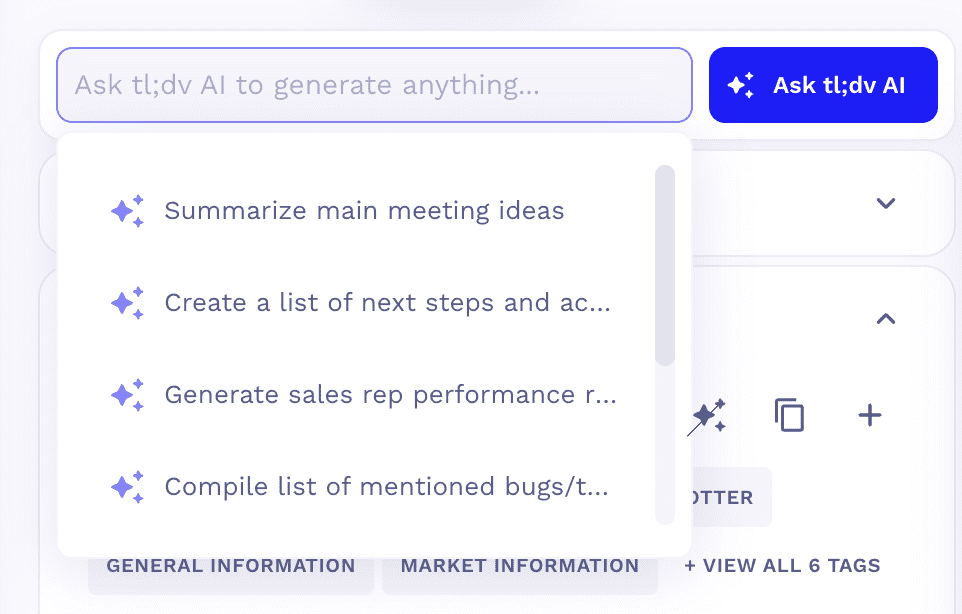
Automation & Integration capabilities
| tl;dv (10) | Gong (10) | |
|---|---|---|
| CRM Integrations | 🟢 In Pro Plan | 🟢 |
| Email Integrations | 🟢 | 🟢 |
| Zapier Integrations | 🟢 in Pro plan | 🟢 in Premium plan |
| Post-Meeting summary email | 🟢 | 🟢 |
| Schedule Reports | 🟢 | 🟢 |
CRM Integrations
Gong offers extensive CRM integrations that enhance its functionality for sales analytics. It supports Salesforce comprehensively, allowing users to import and export data and integrate Gong functionalities directly within Salesforce through a custom app. Gong also fully supports HubSpot integration for easy data connectivity. However, its integration with Microsoft Dynamics is limited to data import only, without support for advanced features like “Engage” and “Forecast”. For other CRMs, Gong provides an API for data uploads, though not all features are supported.
In contrast, tl;dv offers CRM integration through its Pro plan, focusing on integrating meeting insights into CRM systems to facilitate decision-making and customer engagement. It can be integrated with Salesforce, HubSpot, Notion and more.
Gong’s CRM integrations are detailed and tailored for sales teams that need deep integration and data analytics within their CRM systems. Meanwhile, tl;dv prioritizes the accessibility of meeting insights, catering to users who need straightforward CRM integration to enhance their strategies.
Scheduled Reports
Both tl;dv and Gong offer scheduled reporting features to enhance decision-making from communication data. tl;dv allows users to create customizable reports based on specific triggers such as keyword mentions, useful for tracking competitor mentions or specific topics relevant to departmental needs. These reports can be set up to run on a daily basis or in response to particular events.
Similarly, Gong provides customizable reports that focus on sales interactions, allowing users to monitor metrics like keyword mentions, call frequency, and deal progression. These tools help sales managers understand team performance and customer engagement in detail.
Both platforms support strategic business operations by providing timely insights into communications, with Gong focusing on sales-specific analytics and tl;dv offering wider customization for various professional needs.

Note-taking capabilities
| tl;dv (10) | Gong (12) | |
|---|---|---|
| AI Notes | 🟢 | 🟢 |
| Manual notes during calls | 🟢 | 🟢 |
| Tag people in notes | 🟢 | 🟢 |
| Assign tasks | 🔴 | 🟢 Using Salesforce |
| AI Tags / Bookmarks | 🟢 | 🟢 |
| Comments | 🟢 | 🟢 |
AI Notes
tl;dv allows users to personalize the type of notes they receive after each meeting. Users can create “AI tags” to segment meeting content by specific topics, offering a high level of customization in note-taking. Gong, while also providing AI-generated notes and summaries, does not offer this level of personalized segmentation. Gong’s AI focuses more on identifying key points, questions, and action items based on predefined criteria.
Tag People in Notes
tl;dv enhances collaboration by allowing users to tag team members directly in notes, linking discussion points to specific individuals. This feature facilitates follow-up and accountability within teams. Gong also supports tagging individuals in notes, ensuring relevant team members are notified about key parts of the meeting, but the implementation details and ease of use might vary.
Assign Tasks
While Gong supports creating action items and integrating them into workflows, it excels in syncing these tasks with CRM systems like Salesforce. tl;dv’s focus is more on the collaborative aspect of assigning tasks directly within the meeting notes, though specific details on CRM integration for task management might be less emphasized compared to Gong’s capabilities.
Comments
Both tl;dv and Gong allow users to add comments on notes or transcripts, enhancing their collaborative features. Team members can discuss and clarify meeting outcomes directly within the platform. Gong’s comments can be linked to specific parts of the call and integrated into follow-up actions, similar to tl;dv’s functionality.

Security capabilities
| tl;dv (20) | Gong (8) | |
|---|---|---|
| Data retention | 🟢 6 months on FREE plan Unlimited on all paid plans | 🟢 |
| SOC2 Compliant | 🔴 (certification underway) | 🟢 |
| SAML-based SSO | 🟢 Only on Enterprise | 🟢 |
| GDPR Compliant | 🟢 | 🟠 Partial |
| EU AI Act Compliant | 🟢 | 🔴 No due to Sentiment Analysis |
| Uses your data to train AI | 🟢 (No, your data is kept private) | 🟠 Yes, its opt-in |
| Private storage | 🟢 Only on Enterprise | 🔴 not disclosed |
| Anonymised sensitive data sent to LLMs | 🟢 | 🔴 not disclosed |
| Meeting data chunking and randomizing | 🟢 | 🔴 not disclosed |
| BAA with LLM providers | 🟢 | 🔴 not disclosed |
| 0-day data retention polity with vendors | 🟢 | 🔴 not disclosed |
Data Retention
tl;dv offers a clear data retention policy, providing 6 months of data retention for users on its Free plan and unlimited retention for all paid plans. In contrast, Gong provides up to 3 years of data retention by default, with the option for data in the company library to be preserved indefinitely until manually deleted. This ensures both platforms cater to different organizational needs regarding data longevity.
SOC2 Compliance
While tl;dv is in the process of achieving SOC2 compliance, showing its commitment to high standards of security and data protection, Gong is already fully SOC2 Type II compliant. Gong’s compliance ensures stringent safeguards for protecting customer data, covering security, availability, confidentiality, and privacy.
SAML-based SSO
Both tl;dv and Gong offer SAML-based Single Sign-On (SSO) to enhance secure and streamlined access management. tl;dv provides this feature for its Enterprise users, while Gong supports SAML-based SSO through common Identity Providers such as Google, Microsoft, and Salesforce, making it accessible to a broad range of users.
GDPR Compliance
As an EU-based tool, tl;dv is fully compliant with GDPR, ensuring adherence to European data protection regulations. Gong also complies with GDPR, employing various tools and certifications like ISO 27701 and ISO 27018. However, Gong’s GDPR compliance includes certain limitations that may require users to evaluate specific needs.
EU AI Act Compliance
tl;dv is compliant with the EU AI Act, demonstrating its dedication to ethical AI practices and regulatory adherence. Conversely, Gong does not fully comply with the EU AI Act, particularly due to its use of sentiment analysis, which does not align with all the requirements of this regulation.
Uses Your Data to Train AI
tl;dv ensures that data is kept private and not used to train AI, while Gong allows users to opt-in for their data to be used in AI training. This provides flexibility for users who prefer their data to remain private or those who are open to contributing to AI development.
Private Storage
Private storage, essential for organizations prioritizing data sovereignty and security, is available on tl;dv for Enterprise users. Gong’s stance on private storage is not explicitly disclosed, which may affect decision-making for users with specific storage needs.
Anonymized Sensitive Data Sent to LLMs
tl;dv anonymizes sensitive data before sending it to large language models (LLMs), enhancing privacy and data protection. In contrast, Gong’s approach to anonymizing sensitive data sent to LLMs is not explicitly disclosed, creating a gap in understanding its data handling practices.
Meeting Data Chunking and Randomizing
To enhance data security and prevent the reconstruction of full conversations, tl;dv employs data chunking and randomizing. Gong does not explicitly disclose its practices regarding the chunking and randomizing of meeting data, which could be a critical factor for organizations focused on data privacy.
BAA with LLM Providers
tl;dv confirms having a Business Associate Agreement (BAA) with LLM providers, ensuring compliance with legal and regulatory standards in data handling and processing. Gong’s status regarding BAAs with LLM providers is not disclosed, which might influence users requiring documented assurances of data protection and compliance.
0-day Data Retention Policy with Vendors
tl;dv maintains a strict 0-day data retention policy with vendors, minimizing the risk of data exposure and ensuring immediate compliance and deletion from third-party service providers. Gong does not clearly disclose a similar policy, except for general privacy commitments. This could be a consideration for users concerned about data retention practices with vendors.
Coaching capabilities
| tl;dv (8) | Gong (8) | |
|---|---|---|
| Playbooks Scorecards | 🟢 | 🟢 |
| Custom Playbooks | 🟢 | 🟢 |
| Template Playbooks | 🟢 | 🟢 |
| Objection Handling | 🟢 | 🟢 |
The thing to note here is that Gong is a sales training and monitoring tool designed to elevate sales teams through data-driven coaching and real-time insights. Its sole purpose is that it is designed to capture and analyze every sales interaction, providing sales reps with personalized recommendations to enhance their performance based on the behaviors of top performers.
This means when it comes to coaching and sales, it’s its core purpose.
Gong’s platform includes playbooks and scorecards that monitor key metrics like topic duration, talk ratios, and question rates, enabling sales managers to pinpoint areas for improvement and ensure best practices are consistently applied.
Additionally, Gong excels in objection handling, offering detailed insights that help sales reps refine their techniques in challenging scenarios. The platform integrates seamlessly with CRM systems like Salesforce, incorporating sales data into broader business workflows, making it essential for high-performing sales teams.
Meanwhile, tl;dv is making notable progress in the sales coaching domain, even though it isn’t solely focused on sales training. tl;dv offers customizable playbooks and scorecards for tracking and developing individual sales performance. One standout feature is the provision of template playbooks for various business functions, which can be quickly adapted to specific needs. These templates cover scenarios such as research interviews, sprint planning, job interviews, customer onboarding, sales demos (including SPIN and BANT), and performance reviews, providing a structured approach to coaching.
Also it’s worth noting that tl;dv is set to launch AI-driven sales coaching, adding advanced analytical capabilities to its platform. This new feature aims to offer personalized coaching insights, similar to Gong. This could be particularly beneficial for teams looking to enhance their overall communication effectiveness alongside specific sales strategies.
While Gong offers specialized tools tailored for sales excellence with deep CRM integration and real-time feedback, tl;dv provides a versatile coaching platform that supports a wide range of business functions, now enhanced with AI-driven insights. Both platforms bring unique strengths, making them valuable for any organization focused on improving sales performance and communication strategies.
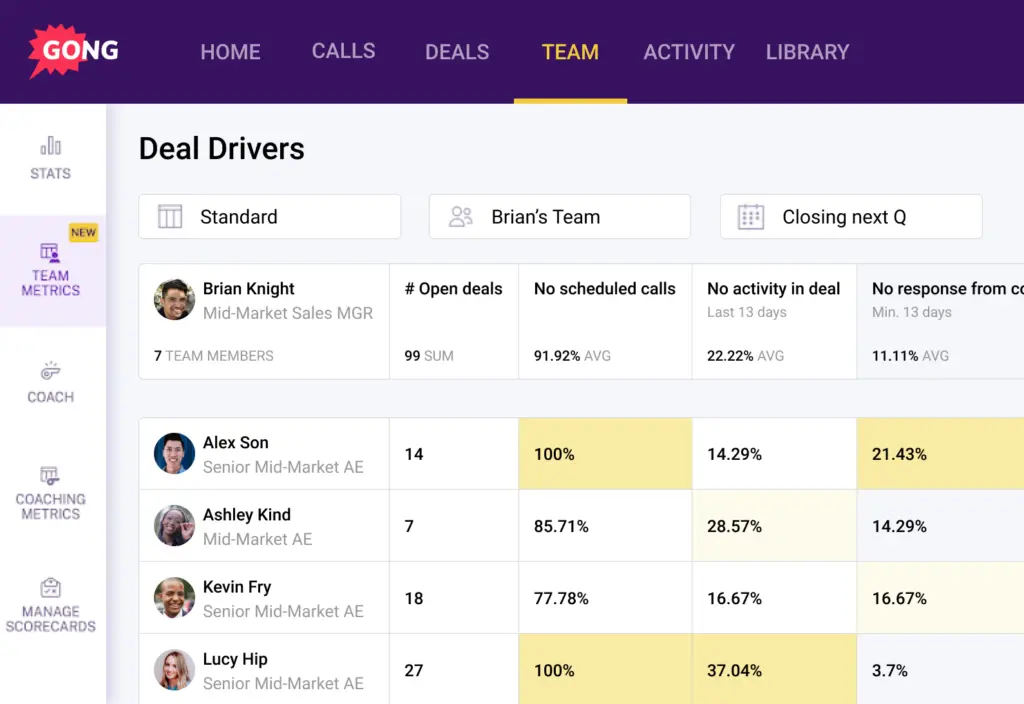
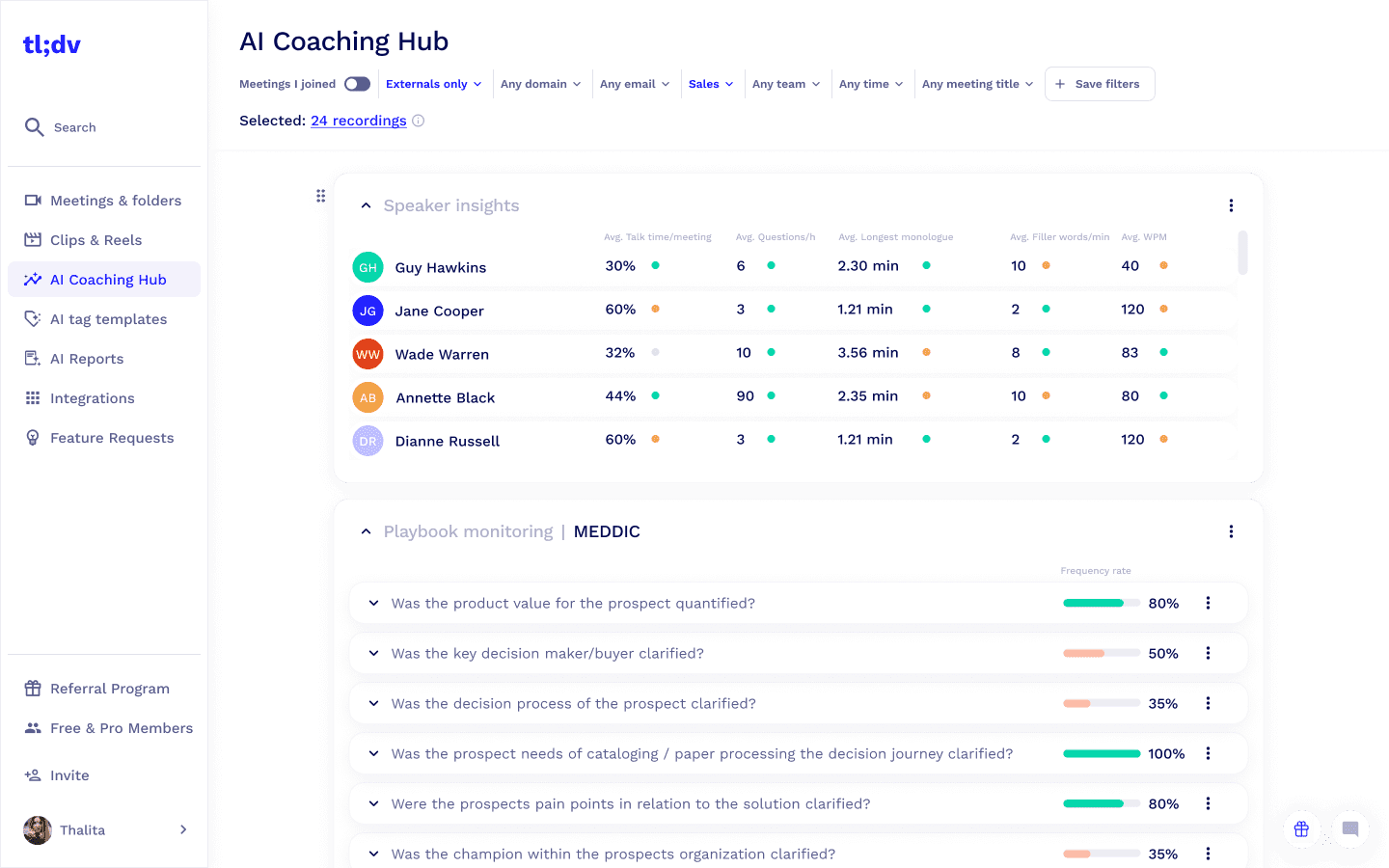
Admin Capabilities
| tl;dv (8) | Gong (4) | |
|---|---|---|
| Apply auto-record of all meetings in the team members’ calendar | 🟢 | 🟢 |
| Apply auto-share of meetings recorded by team members | 🟢 | 🟢 |
| Prevent Deletion | 🟢 | 🔴 |
| Admin rights over all recordings | 🟢 | 🔴 |
Apply Auto-record of All Meetings in the Team Members’ Calendar
tl;dv allows administrators to enforce automatic recording for all scheduled meetings in team members’ calendars. This feature is enhanced by auto-email notifications to participants, ensuring their consent for recording, thus streamlining the process and ensuring comprehensive meeting documentation without individual intervention.
Gong similarly supports the automatic recording of all meetings listed in team members’ calendars. This integration ensures that no significant interaction goes unrecorded, facilitating better tracking and review of meetings.
Prevention Deletion
Prevention deletion is a really important element of recording, particularly when it comes to sales and transparency for both internal and with customers. tl;dv offers a crucial feature that allows administrators to prevent the deletion of meeting recordings. This ensures data security and transparency, maintaining a complete and accurate archive of all recorded meetings. It safeguards against accidental or intentional deletion, ensuring that all interactions are preserved for future reference and accountability.
Gong, however, does not provide a built-in feature to prevent the deletion of recordings. The ability to delete recordings is governed by user permissions set by the tech admin. While this provides some control, it lacks the comprehensive preventive measures against deletion offered by tl;dv. Users with the appropriate permissions can delete recordings and all associated data, which could pose challenges for centralized data management and retention strategies
Admin Rights Over All Recordings
tl;dv grants administrators full control over all meeting recordings. This capability enhances oversight and allows for comprehensive management of meeting data across the organization. Administrators can ensure compliance with data retention policies and maintain a centralized repository of all recorded meetings.
Gong does not offer full admin control over all recordings. While tech admins can manage permissions, they do not have the capability to centrally control all recordings or prevent their deletion, limiting comprehensive oversight and data management

Organizational Capabilities
| tl;dv (12) | Gong (12) | |
|---|---|---|
| Team Workspaces | 🟢 | 🟢 |
| Meetings Library | 🟢 | 🟢 |
| Smart Filters | 🟢 | 🟢 |
| Global Search | 🟢 | 🟢 |
| Search within meetings | 🟢 | 🟢 |
| Folders | 🟢 | 🟢 |
Team Workspaces
Both tl;dv and Gong provide team workspaces, enabling shared environments for collaborative work. In tl;dv, team workspaces are a fundamental feature, ensuring all users can collaborate and share content seamlessly. Gong also supports team workspaces, allowing for efficient collaboration among team members, enhancing the overall productivity and organization of shared projects and meetings
Smart Filters
Both tools offer smart filters that greatly enhance the efficiency of searching and accessing meeting recordings. These filters allow users to quickly locate specific meetings, participants, or key discussions, streamlining the search process and saving time.
Global Search
Both user interfaces offer full global search functionalities, allowing users to search across all meeting recordings, notes, and other relevant data. This capability ensures users can quickly find specific information within the platform, supporting efficient data retrieval.
Support Capabilities
| tl;dv (4) | Gong (2) | |
|---|---|---|
| Support in Free Plan | 🟢 Chat & Email | 🔴 Not applicable as no free plan |
| Priority Support | 🟢 in Pro plan | 🟢 |
Priority Support
As Gong has no free level or free trial, its support is all “priority” with dedicated account managers. tl;dv begins offering priority support with its Pro plan. This level of support includes faster response times, more personalized assistance,
Revenue Intelligence Capabilities
| tl;dv (0) | Gong (4) | |
|---|---|---|
| Forecasting | 🔴 | 🟢 |
| Deal execution | 🔴 | 🟢 |
When comparing the revenue intelligence capabilities of tl;dv and Gong, it becomes clear that there are significant differences, however these differences are not as cut and dried as Gong being “better”.
tl;dv does not offer revenue intelligence capabilities such as forecasting or deal execution. If these features are critical to your business, you may need to consider using Gong as standard. However, it’s essential to be aware that this will come at a significant cost. While not completely transparent, it appears Gong’s pricing for small companies can be quite high, with some plans costing as much as \$1,600 per user annually for teams of 49 or fewer. This means a team of 49 would incur an annual cost of $78,400 before any sales are made.
While the cost per user decreases for larger sales teams, this pricing model requires a substantial investment and may not be cost-effective for smaller businesses.
So, if you are looking for sales coaching features without the hefty price tag, tl;dv offers some valuable functionalities that other softwares don’t. Although it lacks advanced revenue intelligence tools that Gong has, tl;dv can still support your sales team’s development and performance improvement, providing a more budget-friendly option for businesses not ready to invest heavily in comprehensive sales solutions.

Who is it for?
| tl;dv (8) | Gong (4) | |
|---|---|---|
| G2 Rating | 🟢 4.8 | 🔴 4.7 |
| Ease of set up | 🟢 Generous free plan + Clean UI | 🟠 Hard, requires a lot of technical input and set up |
| Localised platform | 🟢 (7 languages) | 🟠 Limited, website appears to have 3 |
| Best suited for whom | 🟢 SMB Sales | 🟢 Large Enterprises |
While it is easy to put both Gong and tl;dv in the same category it’s really important to realize that they are not the same thing. Gong is entirely focused on being a sales-focused tool for large enterprises. The features that it offers are primarily focused on the scaling and generating of more revenue, pure coaching of sales reps, and high-level of reporting based on assumptive data collection on close rates and sales forecasting. All of these can be highly valuable in an enterprise level business with a large dedicated sales team.
It isn’t, however, going to help on a day-to-day basis for internal calls, helping you catch up on departmental meetings, or more general communication. tl;dv however can absolutely support this for a fraction of the cost.
However, tl;dv does offer sales coaching and uses its features and capabilities to offer many of similar benefits, if not like-for-like, as Gong when it comes to sales. This is where it stands apart from other AI notetakers and call recorders, because it does offer some sales-specificity IF you need it.
tl;dv is also very much download and go, whereas Gong’s set-up requires a lot of testing, tweaking and adjustment. It’s a fully integrated solution that also writes emails, links into the CRM but at a level that requires some level of technical expertise and also will require training reps and sales management on how it works.
With this in mind, tl;dv is very much suited for small and medium business sales teams, or businesses who want to integrate this functionality into all their meetings. Gong is great for a big enterprise company that wants a solution focused on sales, profit and customer success, and are happy to pay a large price tag with a fixed contract term.
Verdict: tl;dv vs Gong – which one is the best?
| tl;dv | Gong | |
|---|---|---|
| Transcription | 19 | 24 🟢 |
| Recording | 15 | 18 🟢 |
| Conversational Intelligence | 14 | 16 🟢 |
| Automation & Integrations | 10 | 10 |
| Note-taking | 10 | 12 🟢 |
| Security | 20 🟢 | 8 |
| Coaching | 8 | 8 |
| Admin | 8 🟢 | 4 |
| Organizational | 12 | 12 |
| Support | 4 🟢 | 2 |
| Revenue Intelligence | 0 | 8 🟢 |
| Other | 8 🟢 | 4 |
| Total | 128 🟢 | 122 |
As we have gone over in this article these are two very different tools, and while on the categories side Gong may be the “winner” it doesn’t necessarily mean that it’s the correct tool for your business and your needs. In fact when we break it down to individual scoring, tl;dv actually wins by 6 points.
While Gong offers more languages, many of these are dialects that are also being offered by tl;dv, and many of the functions in Gong are not supported in these languages at present.
Both tl;dv and Gong provide AI insights for single and multiple meetings, keyword tracking, and action item detection. However, Gong includes sentiment analysis, which is not offered by tl;dv due to EU AI Act compliance. This feature allows Gong to provide deeper insights into conversation dynamics and participant engagement, making it more suitable for detailed sales analysis, but also does cause some potential problems when it comes to compliance and ethics within some countries and businesses. It’s also hard to gauge whether or not the nuance of the 70 languages and cultures that these represent will be fully reflected in the capabilities of this either.
When it comes to security, tl;dv excels with its GDPR compliance, strict data retention policies, and commitment to data privacy by not using your data to train AI. Gong, while offering robust security features, uses opt-in data for AI training and lacks some transparency in data handling practices.
Gong Pricing – How Much Does Gong.io Cost?
Gong’s pricing structure is as follows:
- Up to 49 users:
- Base Price: $5,000
- Per User: $1,600 per year billed annually
- 50 – 99 users:
- Base Price: $5,000
- Per User: $1,520 per year billed annually
- 100 – 249 users:
- Base Price: $5,000
- Per User: $1,440 per year billed annually
- 250+ users:
- Base Price: $5,000
- Per User: $1,360 per year billed annually
Additional costs may include:
- Platform Subscription: $5,000
- Professional Services: $7,500 for customer support and training
In terms of cost, Gong’s advanced features come with a high price tag, which may not be feasible for small businesses. Gong’s extensive sales analytics, coaching capabilities, and CRM integration are ideal for large enterprises with dedicated sales teams. tl;dv, on the other hand, offers a more budget-friendly solution that is easy to set up and versatile enough to enhance overall meeting productivity and provide valuable sales coaching functionalities. tl;dv starts from just $18 per user/per month when paid annually, and even on the higher end is still cheaper, delivering 90% of the same value at 10% of the cost. There’s also no minimum seats and no base price to pay either.
For sales coaching and performance improvement, Gong provides a comprehensive suite of tools tailored for high-performing sales teams, while tl;dv offers customizable playbooks and AI-driven insights suitable for small and medium-sized businesses looking to enhance their sales strategies without significant investment.
Ultimately, tl;dv is best suited for small to medium-sized businesses that need a flexible, cost-effective tool to enhance meeting productivity and provide some sales coaching functionalities. It supports multiple languages, ensures strong data security, and is easy to set up and use, making it ideal for organizations looking to manage meetings efficiently and improve communication without a hefty price tag.
Gong is the better choice for large enterprises with dedicated sales teams that require in-depth sales analytics, detailed conversation intelligence, and robust revenue intelligence capabilities. It’s a comprehensive solution focused on sales performance, coaching, and customer interactions, suitable for businesses willing to invest significantly in a tool that provides extensive sales insights and integrates deeply with CRM systems. However, it is likely that many of the features will end up being unused.
The choice between tl;dv and Gong ultimately depends on your specific needs, budget, and the scale of your sales operations. If advanced sales analytics and deep CRM integration are critical, Gong is the way to go. For broader meeting productivity and cost-effectiveness, tl;dv offers a compelling alternative.


